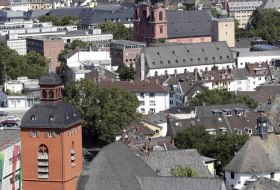
searchMenu



The parish church of St. Quentin's is the oldest parish church in Mainz, first documented in 774. It is a hall church in the late Gothic style built between 1288 and 1330. Its belfry dates from 1489 and included a watchman's dwelling. Today, it contains four bells, including the oldest bell in Mainz known as the "Lumpenglöckchen" a beehive bell made in 1250. To the left of the High Altar, we find a larger than life-sized statue of St. Quentin, the patron saint of prisoners. To the right is St. Blaise, the second patron saint of the…

The church was built in 1712 in place of the destroyed Michaelis chapel and later rebuilt and extended with neo-gothic forms. Under the nave is a vaulted, medieval ossuary. There are due to the spatial narrowness of the cemetery, the bones excavated during reestablishment collected and stored. It is already reported by him in 1496. Later it was abandoned and forgotten. Only in 1981 it was rediscovered during construction. History / Stories / Anecdotes: The Ossuary was discovered on October 3, 1981 during construction work in…

The Trullo - the Trulli - the special little vineyard house in Rheinhessen. Former shelters in the vineyards for the workers, but also intended for the "Wingertschütz" who guarded the vineyards.

The trullo, the trulli - the special little vineyard house in Rheinhessen. Former shelters in the vineyards for the workers, but also intended for the "Wingertsschütz" who guarded the vineyards.

A church dedicated to St. Martin is mentioned in a Fulda document as early as 788. At that time, the church was owned by the Otakar noble family who lived here. In 1348 it belonged to the parish of Wackernheim as a parish church. In the middle of the 16th century, at the instigation of the Palatine Electors, first the Lutheran and then the Reformed confession was introduced. When the church was divided, the church, which had been badly damaged in the Thirty Years' War, fell to the Reformed, who made up the majority of the inhabitants. The…

Along almost the whole length, the defensive wall, which runs parallel to Burgunderstraße, is still preserved, though on different heights. It follows the course of the defence moat, which was filled in last century, and runs in a straight line towards the west to the Stiegelgässer Tor. At about halfway this tower with a pointed roof, attached to a house, could be preserved.

The so-called "Mistkaut" between Nierstein and Nackenheim in the middle of the vineyards on the "Roten Hang", is located directly on the "RheinTerrassenWeg" and the "Butttenmännie-Wanderweg". The relic of earlier times from agriculture and viticulture was once used as a temporary storage for manure. Today, wine tastings and festivals are held there. It takes its name from a rock niche (Kaut) in the Rotliegende. This was created by mining rock gravel (Kummer), which was used as fertiliser. Because of its high potash content, the…